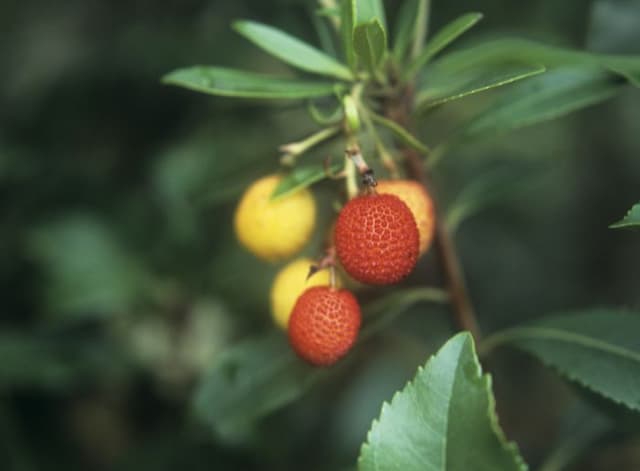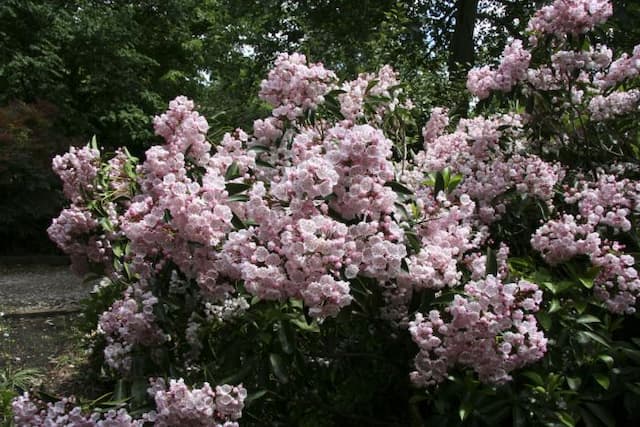Lindley's Rhododendron Rhododendron lindleyi

ABOUT
The plant, commonly known for its scented flowers, exhibits a lush, evergreen foliage that creates a verdant backdrop throughout the year. The leaves are typically large, leathery, and have a glossy dark green hue that adds to the plant's aesthetic appeal. The true spectacle, however, lies in its blossoms. These emerge in trusses, clustering at the ends of the branches. Each truss is a stunning assembly of trumpet-shaped flowers, which boast a creamy white color. The blooms are notable for their prominent, yellow-green blotch that paints a vivid contrast against the petals. The delightful fragrance they exude is an added enchantment, attracting pollinators and pleasing the senses of those who pass by. After the flowering season, the plant produces seed pods that add another dimension of interest to its appearance. Overall, the plant presents a captivating display of color and form, making it a prized specimen in any landscape where it thrives.
About this plant
 Names
NamesSynonyms
Lindley's Rhododendron, Lindleyi Rhododendron.
Common names
Rhododendron lindleyi Steud., Azalea lindleyi Griff., Rhododendron gibsonii Hook., Rhododendron lowii Hook. f.
 Characteristics
CharacteristicsLife cycle
Perennials
Foliage type
Evergreen
Color of leaves
Green
Flower color
White
Height
6 feet [1.8 meters]
Spread
6 feet [1.8 meters]
Plant type
Shrub
Hardiness zones
10
Native area
Southeast Asia
Benefits
 General Benefits
General Benefits- Aesthetic Appeal: Rhododendron lindleyi, also known as the Lindley's Rhododendron, has large, attractive flowers that enhance the visual appeal of gardens and landscapes.
- Shade Tolerance: Lindley's Rhododendron is suitable for planting in shaded areas where other plants might struggle to grow.
- Pollinator Attraction: The blossoms of Lindley's Rhododendron attract bees and other pollinators, supporting local ecosystems and biodiversity.
- Soil Erosion Control: The root system of Lindley's Rhododendron helps to stabilize soil, reducing erosion on slopes and in areas with loose soil.
- Seasonal Interest: With a blooming period typically in late spring, Lindley's Rhododendron provides seasonal interest and color to gardens during this time.
- Habitat Support: Lindley's Rhododendron can provide shelter and food for various species of wildlife, contributing to a healthy and diverse habitat.
- Cultural Significance: In some cultures, Rhododendrons are symbols of beauty and are often celebrated in festivals and garden shows.
 Medical Properties
Medical PropertiesThis plant is not used for medical purposes.
 Air-purifying Qualities
Air-purifying QualitiesThis plant is not specifically known for air purifying qualities.
 Other Uses
Other Uses- Ornamental Landscaping: Rhododendrons are widely used as ornamental plants in landscaping due to their striking flowers and broad evergreen leaves.
- Honey Production: While some Rhododendron species contain toxic nectar, certain types like Rhododendron lindleyi can be a source for producing honey when bees forage on their flowers.
- Educational Tool: These plants are used in botanical gardens and educational programs to teach about plant species diversity and ecological relationships.
- Cultural Symbolism: In some cultures, Rhododendrons hold symbolic meaning and are used in festivals and celebrations as emblems of beauty and prosperity.
- Photography Subject: The vibrant flowers and unique structures of Rhododendrons make them popular subjects for botanical photographers and artists.
- Soil Erosion Control: Their extensive root systems can help stabilize soil and prevent erosion on slopes or in areas prone to landslides.
- Habitat Restoration: Rhododendron species can be used in forest and habitat restoration projects to re-establish native flora.
- Literary Inspiration: Due to their beauty, Rhododendrons have been the inspiration for many literary works and poems, enhancing cultural arts.
- Climate Indicator: Changes in the flowering time of Rhododendrons can serve as indicators of climate change for research studies.
- Dye Production: Some Rhododendron species have been used historically to produce dyes for textiles, though this is less common today.
Interesting Facts
 Feng Shui
Feng ShuiThe Azalea is not used in Feng Shui practice.
 Zodiac Sign Compitability
Zodiac Sign CompitabilityThe Azalea is not used in astrology practice.
 Plant Symbolism
Plant Symbolism- Beware: Rhododendron, often referred to as azaleas, are known for their toxicity. Their symbolism of caution is linked to the danger they present if ingested.
- Abundance: The lavish blooms of the Rhododendron plant symbolize abundance and wealth.
- Beauty and Elegance: Rhododendrons are widely admired for their attractive flowers, which symbolize beauty and elegance in many cultures.
- Taking Care of Oneself: Due to its poisonous nature, it also teaches the importance of taking care of oneself and not to consume or partake without knowledge.
- Survival: Rhododendrons are hardy plants capable of thriving in challenging conditions, symbolizing the human ability to endure and persevere.
 Water
WaterRhododendrons, including Rhododendron lindleyi, generally require even moisture and do not like to dry out completely. They should be watered thoroughly, ensuring that water reaches the root zone. During the growing season, water the plant once a week with about 1 gallon per foot of plant height, adjusting for rainfall. In the absence of rain and high temperatures, check the soil moisture to decide if more frequent watering is necessary. Reduce watering in the winter months when the plant is dormant, but do not let the soil dry out completely.
 Light
LightRhododendron lindleyi, commonly known as Lindley's Rhododendron, thrives in partial to full shade. They should be placed where they receive dappled sunlight or morning sun and afternoon shade, which mimics their natural habitat under the forest canopy. Direct afternoon sunlight should be avoided to prevent leaf burn.
 Temperature
TemperatureLindley's Rhododendron prefers temperate conditions and can generally tolerate a range of temperatures, from winter lows of about 20°F to summer highs around 80°F. They are hardy and can survive brief fluctuations outside these temperatures, but prolonged exposure to temperatures below 20°F or above 85°F can be detrimental. Ideal growing conditions would maintain a stable range between 50°F and 75°F.
 Pruning
PruningLindley's Rhododendron benefits from pruning to maintain shape, remove dead or diseased wood, and encourage bushier growth. The best time for pruning is immediately after flowering so as not to remove next year's buds, which are set in summer. Prune selectively, cutting back just above new growth points, and avoid heavy pruning as rhododendrons can be slow to recover.
 Cleaning
CleaningAs needed
 Soil
SoilThe best soil mix for Rhododendron lindleyi, commonly known as Lindley's Rhododendron, should be well-draining, high in organic matter, and have an acidic pH between 4.5 and 5.5. A mix of peat moss, pine bark, and perlite in equal parts is often recommended to maintain the required acidity and drainage.
 Repotting
RepottingLindley's Rhododendron should be repotted every 2 to 3 years to refresh the soil and accommodate its growing root system. Spring is the best time for repotting, just before new growth begins.
 Humidity & Misting
Humidity & MistingLindley's Rhododendron thrives in moderate to high humidity levels, ideally between 50% and 60%. It benefits from a humid environment that mimics its natural cloud forest habitat.
 Suitable locations
Suitable locationsIndoor
Place in bright, indirect light with acidic soil and keep the humidity high.
Outdoor
Plant in dappled shade, ensure soil acidity, and protect from harsh winds.
Hardiness zone
9-10 USDA
 Life cycle
Life cycleRhododendron lindleyi, commonly known as the Lindley's Rhododendron, begins its life as a seed that germinates in well-draining, acidic soil, often with the help of mycorrhizal fungi. The seedling stage is characterized by the emergence of the first leaves and root system which are critical for photosynthesis and nutrient uptake. As it enters the vegetative stage, the plant develops a woody stem and a larger root system, along with the distinctive evergreen leaves. The maturity stage is reached when the plant is capable of flowering, producing showy flowers that attract pollinators for sexual reproduction. After pollination, the flowers develop into seed capsules which, when mature, open to release seeds, thereby completing the reproductive stage. With proper conditions, Rhododendron lindleyi may continue to grow and reproduce for many years, often experiencing cycles of dormancy during colder months.
 Propogation
PropogationPropogation time
Spring to early summer
Rhododendron lindleyi, commonly known as Lindley's Rhododendron, is typically propagated through semi-hardwood cuttings. This method is most popular due to its effectiveness and relative simplicity. The best time to take cuttings for propagation is in the late summer, as this is when the wood has partially matured but is not yet fully hardened. Cuttings should be 4 to 6 inches long and be taken from healthy, disease-free parent plants. The lower leaves are removed, and the base of the cutting is dipped in a rooting hormone before being planted in a mix of peat and perlite. High humidity and indirect sunlight are crucial for the successful rooting of these cuttings, while maintaining the soil's moisture without it being waterlogged is also key. With appropriate care and conditions, new plants will develop a strong root system within a few weeks to a few months.









